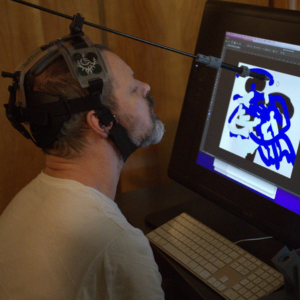Interviewer: Vignesh Vanchinathan
Interviewee: Alexander Tinana
Role: President of JHU-VME
Q. Tell us about yourself!
A. My name is Alexander Tinana, and I am a senior majoring in Materials Science & Engineering. Coming into Hopkins, I’ve always had an interest in medical devices, and I wanted to find an avenue to explore this interest. At the beginning of my sophomore year, I joined the Volunteers for Medical Engineering, where we helped design a modular assistive helmet for an artist with cerebral palsy that allowed him to switch between a digital stylus and a rubberized typing tool with ease. What I loved about the experience was that I was not only able to put my engineering skills to use to help someone, but also directly see the impact that this device had on his life. As an aspiring doctor specializing in Physical Medicine and Rehabilitation, engaging in a human-centered approach to engineering and working with people from diverse academic backgrounds has deepened my passion for exploring the intersection of medicine and engineering.
Q. Tell us about your project(s) and the work your club does!
A. The Johns Hopkins Volunteers for Medical Engineering (JHU-VME) focuses on designing and developing assistive devices for individuals with disabilities in the greater Baltimore community. We work closely with our parent organization, The IMAGE Center of Maryland, to identify and address the needs of our clients. Each semester, our teams collaborate on innovative projects, giving our members hands-on experience in the engineering design process. From ideation to prototyping, we focus on creating impactful solutions that enhance the daily lives of those we serve. Some of our recent projects include developing a seizure detection system using a custom smartwatch app, as well as an e-trike for muscular dystrophy.
Q. How do you encourage interdisciplinary collaboration?
A. Interdisciplinary collaboration is integrated into our club’s mission. We accept members from various engineering disciplines and beyond, such as mechanical engineering, computer science, neuroscience, and more to bring a wide range of perspectives to our projects. We encourage collaboration through cross-functional teams where students with different skill sets work together to tackle complex challenges. For example, students majoring in mechanical engineering might focus on the physical design of a device, while students majoring in computer science might work to develop the software needed to interface with it. This approach ensures that our projects are robust and well-rounded. Additionally, we host workshops, such as CAD and design process training, that help bridge the knowledge gaps between disciplines and foster a collaborative environment.
Q. What types of roles do different engineering majors have on your team?
A. At JHU-VME, we benefit from a wide array of engineering disciplines, each contributing unique expertise to our projects. For example, Mechanical Engineers typically handle the physical design and prototyping of devices, ensuring that the structures we create are ergonomic and functional. Electrical Engineers work on circuit design and integrating hardware components, especially in projects like our seizure detection system, where sensors and power management are critical. Computer Science and Computer Engineering majors are key to developing the software and algorithms that interface with our devices, such as apps that monitor and control the hardware. Biomedical Engineers often focus on ensuring that our devices meet health and safety standards, making sure that the end products are suitable for individuals with disabilities. Each major plays an essential role in transforming ideas into functional devices, and this interdisciplinary collaboration ensures that our projects are comprehensive and impactful.
Q. What advice would you give to freshmen at Hopkins looking to expand their experience beyond a specific engineering field?
A. My advice to freshmen is to seek out opportunities that challenge you to think beyond the boundaries of your major. Engineering is inherently interdisciplinary, and the more you expose yourself to different perspectives, the more well-rounded you’ll become. Clubs like JHU-VME are a great place to start because they allow you to collaborate with students from various backgrounds and tackle real-world problems. Don’t be afraid to join projects where you don’t know all the answers—that’s part of the learning process. Lastly, leverage resources like workshops and mentoring from upperclassmen or alumni to gain insights into fields outside your own. The goal is to build a diverse skill set that will serve you well no matter what engineering challenges you face in the future.
Q. What is the most unexpected thing you’ve learned from being leadership of JHU-VME?
A. One of the most unexpected things I’ve learned is how crucial communication is to the success of an engineering project. While technical skills are essential, being able to clearly articulate ideas, manage team dynamics, and maintain client relationships is equally important. I’ve seen firsthand how interdisciplinary collaboration thrives on open communication, ensuring that everyone on the team is aligned on goals and expectations. It has been eye-opening to realize how much leadership in engineering is about guiding teams through effective communication, ensuring that the work not only gets done but that it is done collaboratively and with the end-user in mind.

